Context & Background
- Myanmar junta ended emergency rule in June 2024 and announced elections for December, amid an ongoing civil war.
- The 2021 military coup dismantled the elected civilian government, triggering:
- 5,000+ civilian deaths.
- 2.5 million+ internally displaced persons (IDPs).
- India’s current approach: Continued engagement with the junta while ignoring the pro-democracy resistance.
Relevance : GS 2(International Relations)

India’s Current Posture: Flawed Assumptions
- Realpolitik Argument: India must protect its “interests” (security, connectivity, China containment) by engaging with whoever is in power — even the junta.
- Problem: Assumes that values (democracy, human rights) are separate from interests.
- Key Critique: India’s definition of “interests” is narrow, strategic, and short-sighted.
The Civil War Landscape in Myanmar
- Resistance Forces: Led by the National Unity Government (NUG) — an alliance of:
- Pro-democracy activists.
- Ethnic armed groups.
- Civil society and trade unions.
- Their goal: Overthrow the 2008 military-drafted Constitution and establish a federal democratic union.
India’s China Problem in Myanmar
- China’s Approach: Arms sales, strategic infrastructure (e.g. Kyaukphyu port), backchannel diplomacy.
- India’s Missed Opportunity: While both can sell weapons, only India can offer democratic federalism as a model — an edge China lacks.
- By staying neutral or silent, India risks:
- Losing goodwill among Myanmar’s future leadership.
- Ceding long-term influence to China.
A Progressive Indian Myanmar Policy: Why It’s Plausible & Necessary
Two Core Pivots:
- Democracy
- Human Security
Policy Recommendations (4 Interlocking Steps)
Support Myanmar’s Pro-Democracy Forces
- How?
- Engage with NUG and ethnic political entities.
- Launch capacity-building programs: Constitution-making, federalism, decentralization.
- Use India’s democratic experience as soft power leverage.
- Why?
- Builds long-term strategic alliances.
- Signals India’s moral and political leadership in Asia.
Immediately Halt All Weapon Sales to the Junta
- Facts & Findings:
- Indian PSUs have reportedly sold navigation equipment and diesel to the Myanmar military post-coup (Justice For Myanmar; Frontier Myanmar).
- Why Stop?
- Junta is using all three military branches (army, navy, air force) to attack civilians.
- Weapons, even non-lethal, contribute to junta’s war infrastructure.
- Ethical Cost: Contradicts India’s global image as a democratic “Vishwabandhu”.
Open Cross-Border Humanitarian Corridors
- Conflict Zones near India:
- Sagaing Region, Chin State, and Rakhine State – key hubs of displacement.
- Action Steps:
- Reinstate Free Movement Regime (FMR), revoked in Feb 2024.
- Partner with local NGOs and global humanitarian networks.
- Deliver aid through Mizoram – which has local asylum infrastructure.
- Learn from Thailand’s cross-border aid model.
- Safeguards:
- Aid delivery must bypass the junta.
- Use pre-vetting and strict border checks to avoid contraband leaks.
Stop Deporting Myanmar Asylum Seekers
- Current Reality:
- 115 asylum seekers deported from Manipur (latest: June 2024).
- 27 Chin refugees detained in Assam
- Legal & Ethical Obligations:
- India has not ratified the 1951 Refugee Convention, but must abide by customary international law.
- Non-refoulement principle prohibits returning refugees to danger.
- Indian Constitution & human rights norms support humane refugee treatment.
Broader Strategic and Ethical Insights
India’s Core Strengths in Myanmar
- Democracy: Unique appeal to pro-democracy forces, unlike China.
- Federalism: A real-time model for Myanmar’s future constitution-making.
- People-to-People Ties: Especially in the Northeast (ethnic overlaps with Chin, Mizo populations).
- Regional Power Status: Enables India to shape the narrative of peace and reconstruction.
Risks of Current Policy
- Loss of moral legitimacy.
- Alienation of future Myanmar leaders.
- Strengthening China’s grip on Myanmar’s military-industrial complex.
- Increased instability on India’s Northeast border (influx of refugees, militancy).
Conclusion: Walking the Talk of “Vishwabandhu”
- India often claims to stand with the people of Myanmar.
- Now is the time to back that rhetoric with action — through a balanced approach that:
- Supports democratic transition,
- Respects humanitarian needs,
- Secures India’s strategic interests, and
- Elevates India’s regional leadership.



